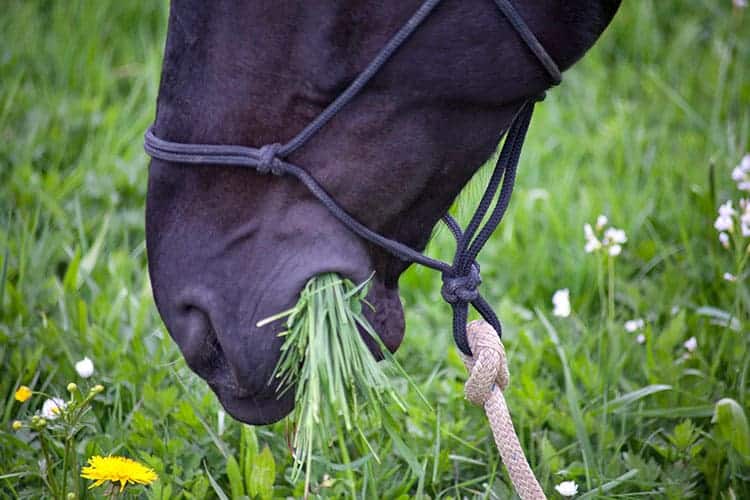Abruptly putting a horse on pasture can lead to colic or laminitis. Here’s advice to help avoid health problems.
Q. This spring, I moved my horse to a new barn with grass turnout. My horse hasn’t been on pasture since I got him, and I’m unsure how to make this transition. I know it needs to be gradual, but how gradual, and how do I make it work?
A. I’m sure your horse will appreciate the opportunity to be turned out and have pasture access. But you are correct: Sudden dietary changes, whether it’s the introduction of grain, a hay change, or a move to pasture, can lead to colic and laminitis if done abruptly, whereas a gradual transition allows the digestive tract to adapt. The types and amounts of enzymes the horse’s digestive system secretes are diet-specific. This is also true of the bacteria composing the horse’s hindgut microbiome.

When equine diets change suddenly, feed components that should be digested and absorbed in the small intestine might not be. They might instead reach the hindgut, disrupting the microbiome microbial population. This can result in gas production, hindgut pH reductions (becoming more acidic), as well as die-offs of certain bacterial populations, causing toxin release. All of this can contribute to colic and laminitis.
Early spring pasture contains a lot of moisture, protein, and nonstructural carbohydrates (NSC). NSC includes sugar and starch, as well as more complex fructan sugars. High-NSC diets have two problems:
- A sudden transition to a diet high in NSC can cause the hindgut disruption already mentioned, because sugar and starch that should be removed in the small intestine are not; and
- For horses with metabolic issues such as insulin dysregulation and equine metabolic syndrome, NSCs can induce laminitis and founder.
To minimize hindgut disruption, a slow introduction to pasture is necessary, especially for sensitive horses with metabolic conditions. Understanding that these individuals might not be good candidates for any pasture is important. Before you embark on this project, make sure your horse is a good candidate for pasture.
If the barn manager expects pasture to provide real nutritional benefits, fields must be well-established before introducing horses. Putting horses on new pasture too early and before the plants are well-established can be tempting. Wait until the pasture has at least 6 inches of grass before grazing. A safe rule of thumb is that the bottom 4 inches always belong to the plant. If pastures are grazed below that height, you start to rob the plant of its ability to maintain itself, and ultimately your pastures will become overgrazed and plants will die, leaving bare patches and opportunity for weeds to take hold.
Assuming you have the minimum 6 inches of growth, introduce your horse to the pasture initially for just 15 minutes. This might require hand-grazing, because not all horses are going to want to come back inside after only 15 minutes on such a delicacy as spring grass! Then increase the grazing time by about 15 minutes every day until your horse is grazing for about four hours total. Stay at four hours per day for at least a week before granting unlimited access.
Clearly this process is labor-intensive, so it can be helpful to get creative about how you pull it off. The initial 15-30-minute periods can be fairly easily achieved before or after a ride. Allowing 15 minutes before a ride is a great way to get some forage in the stomach. If time is short, do your grooming while your horse grazes, or just hang out and enjoy his company. Then add some time after your ride as a reward. Schedule grazing so longer turnout periods happen on weekends or when you have more time. Ask a friend at the barn to help you out. With some teamwork and creativity, you can transition your horse to pasture safely.
